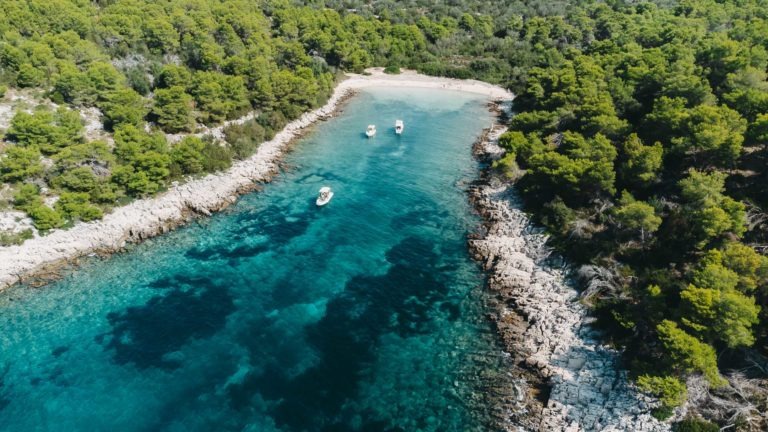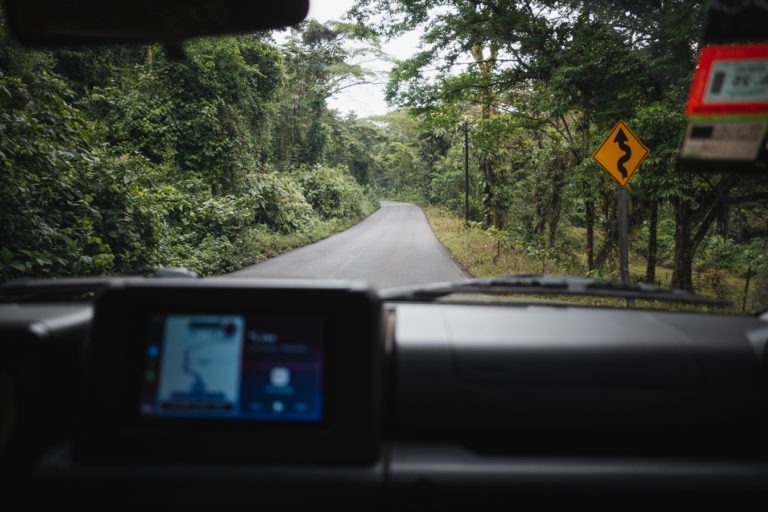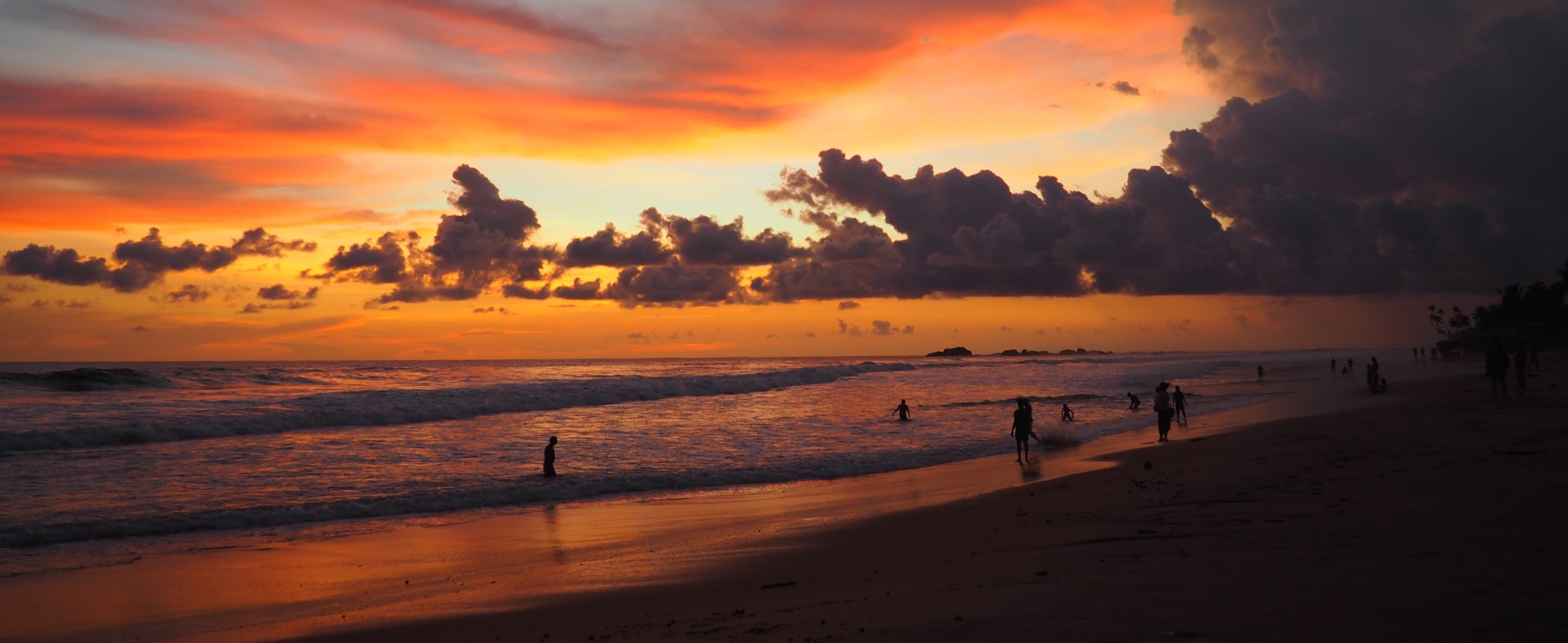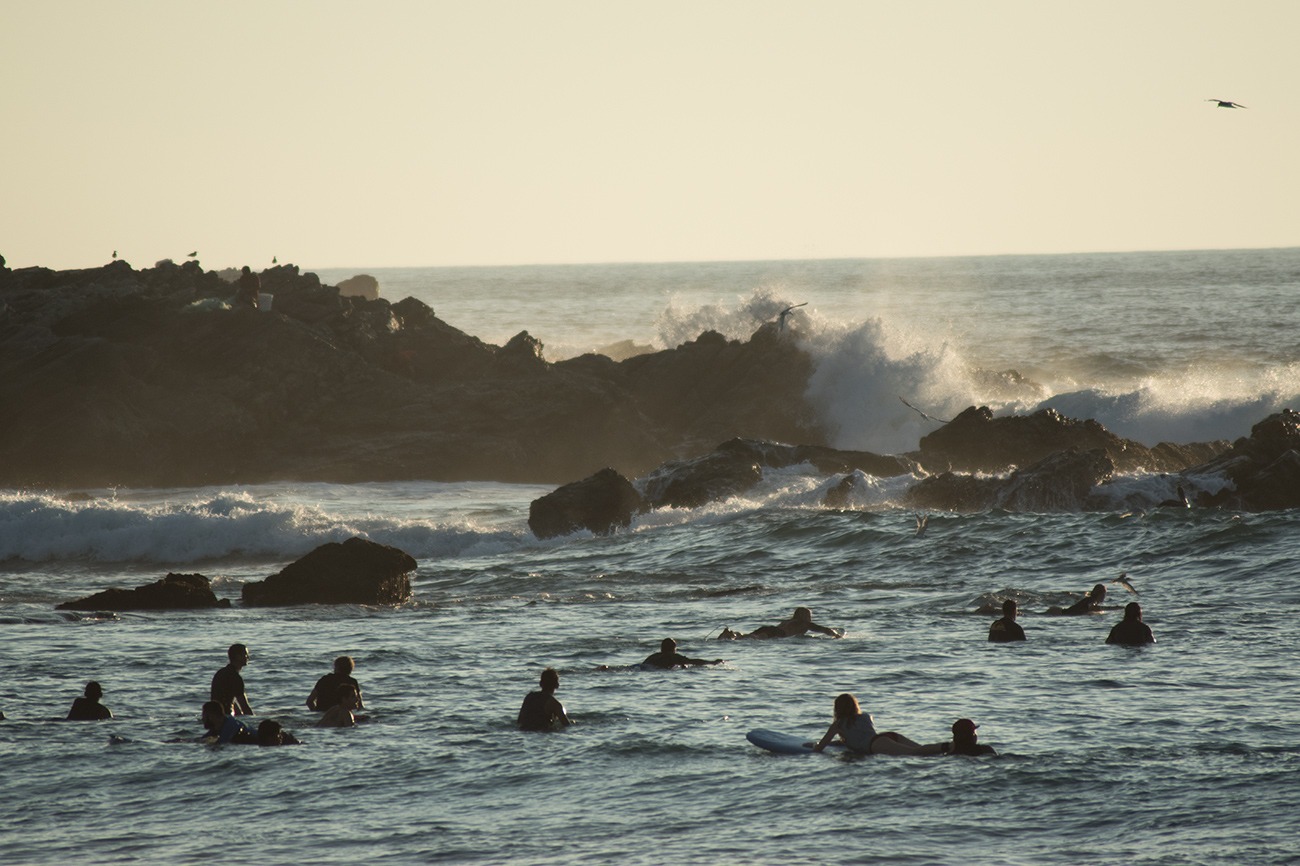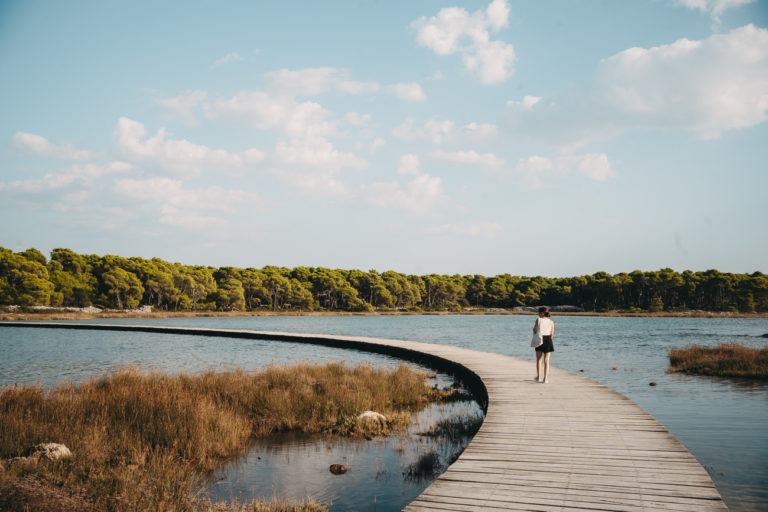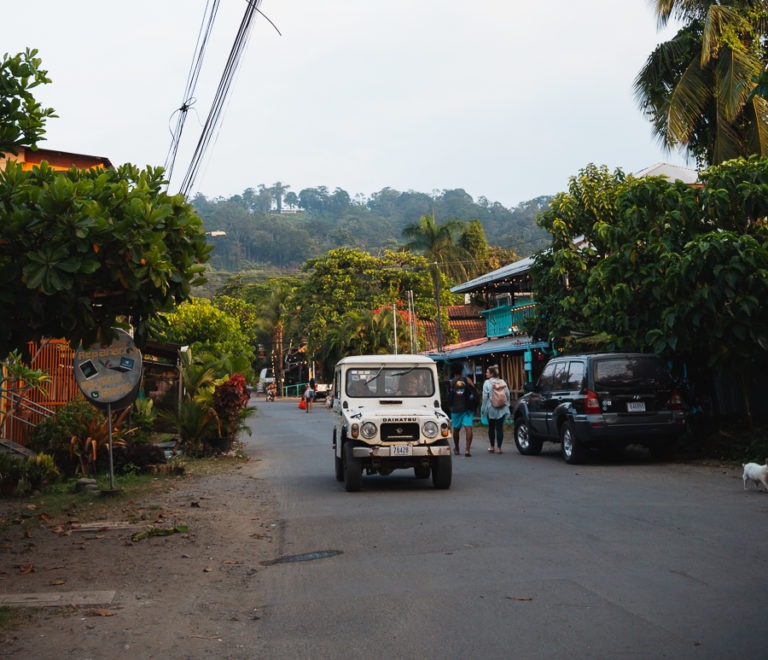Throughout the years we have been to a couple of countries. Costa Rica is without a doubt among our two or three favorite destinations.
Costa Rica is a dream destination for surfers, offering waves for all skill levels, warm waters, and an atmosphere brimming with pura vida vibes. Whether you find yourself on the Caribbean side or the Pacific coast, you’re in for an unforgettable experience. In this guide, we’ll dive deep into the surf culture, the must-visit spots, and everything you need to know about Costa Rica Surfing.
Costa Rica’s water feels like a warm bath, with temperatures staying around 26–29°C (79–84°F) year-round. No wetsuit needed – just grab your boardshorts or a bikini. Now, let’s dive into the best Costa Rica Surfing spots in this tropical paradise. 🌊
Surf Spots at the Pacific Coast
Santa Teresa, nestled on the Nicoya Peninsula along Costa Rica’s stunning Pacific coastline, is a tropical haven known for its bohemian surf vibes and breathtaking sunsets. It’s famous and perhaps a little too famous. But we understand the hype.
This laid-back beach town has become a hotspot for surfers, yogis, and adventure seekers drawn to its world-class waves, pristine white-sand beaches, and lush jungle surroundings. Whether you’re catching waves at Playa Hermosa or strolling barefoot along Playa Carmen at sunset, Santa Teresa offers a perfect blend of serenity and excitement. Santa Teresa is a place we could go back and stay. Forever.
Where to Surf on the Nicoyala Peninsula
Playa Santa Teresa
Santa Teresa, located on Costa Rica’s Pacific coast, is a vibrant surf destination known for its picturesque beach breaks and consistent waves. The long stretch of sandy coastline offers multiple peaks, making it an ideal spot for everyone – from beginners learning to catch their first waves to experienced surfers seeking fast, hollow rides. The waves tend to be punchier and more hollow during low tide, offering fun barrels for those with a bit more skill.
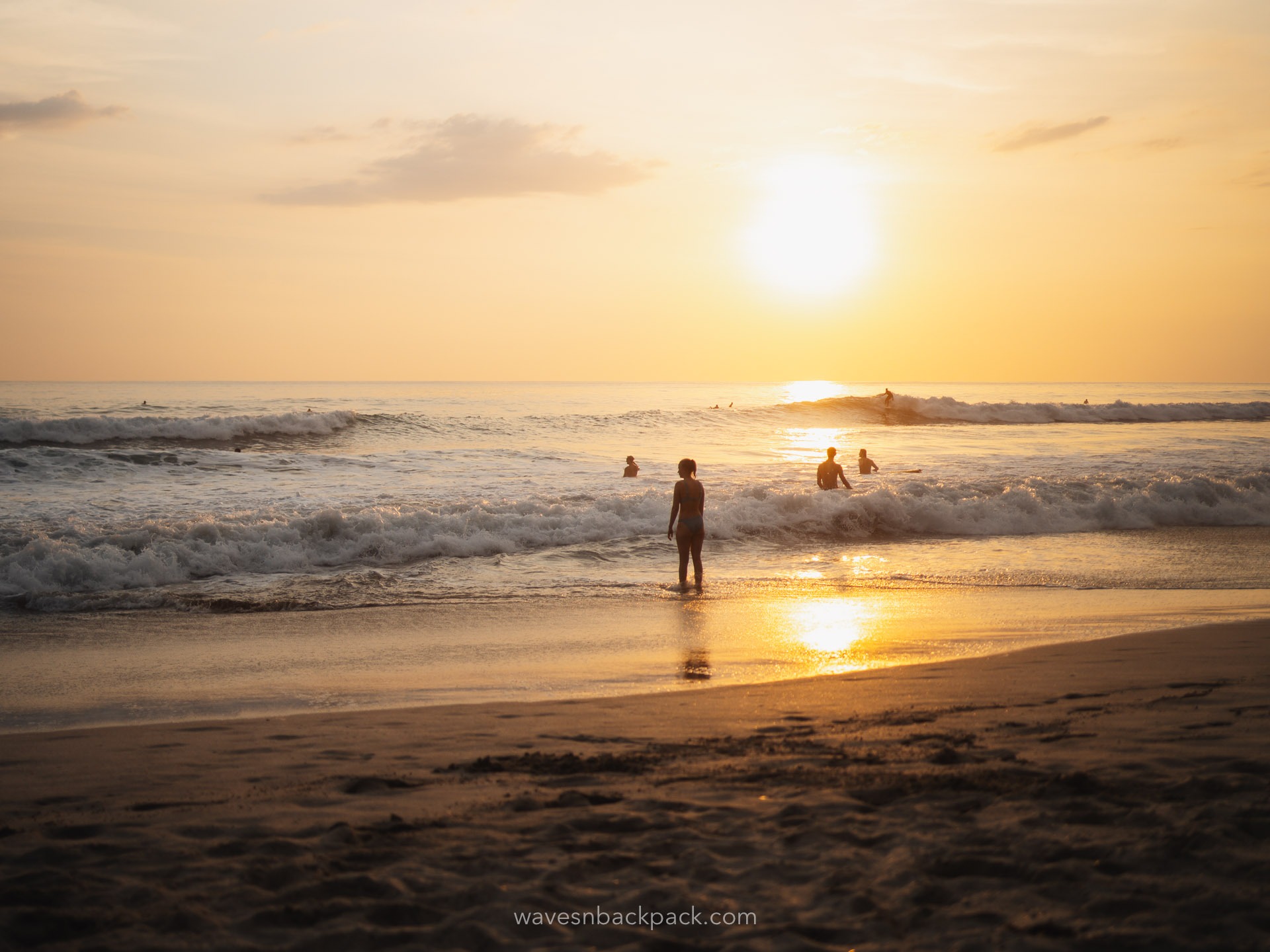
Beyond the surf, the lively town of Santa Teresa is filled with hip cafés, surf shops, and a laid-back atmosphere that attracts digital nomads.
- Skill Level: All levels
- Wave Type: A long beach with multiple peaks, making it ideal for surfers of all levels. Oh boy. Those mornings I had there. Sandy bottom!
- Important Notes: Conditions vary throughout the day. Best surf is usually in the morning or at low tide.
Playa Carmen
Playa Carmen is a popular surf spot known for its long, mellow beach break and reliable waves. The soft, sandy bottom and multiple peaks make it a great choice for beginners and intermediate surfers, while occasional faster sections during mid to low tide can offer fun rides for more experienced surfers.
The wave quality remains fairly consistent throughout the year, making it a dependable option for a laid-back surf session.
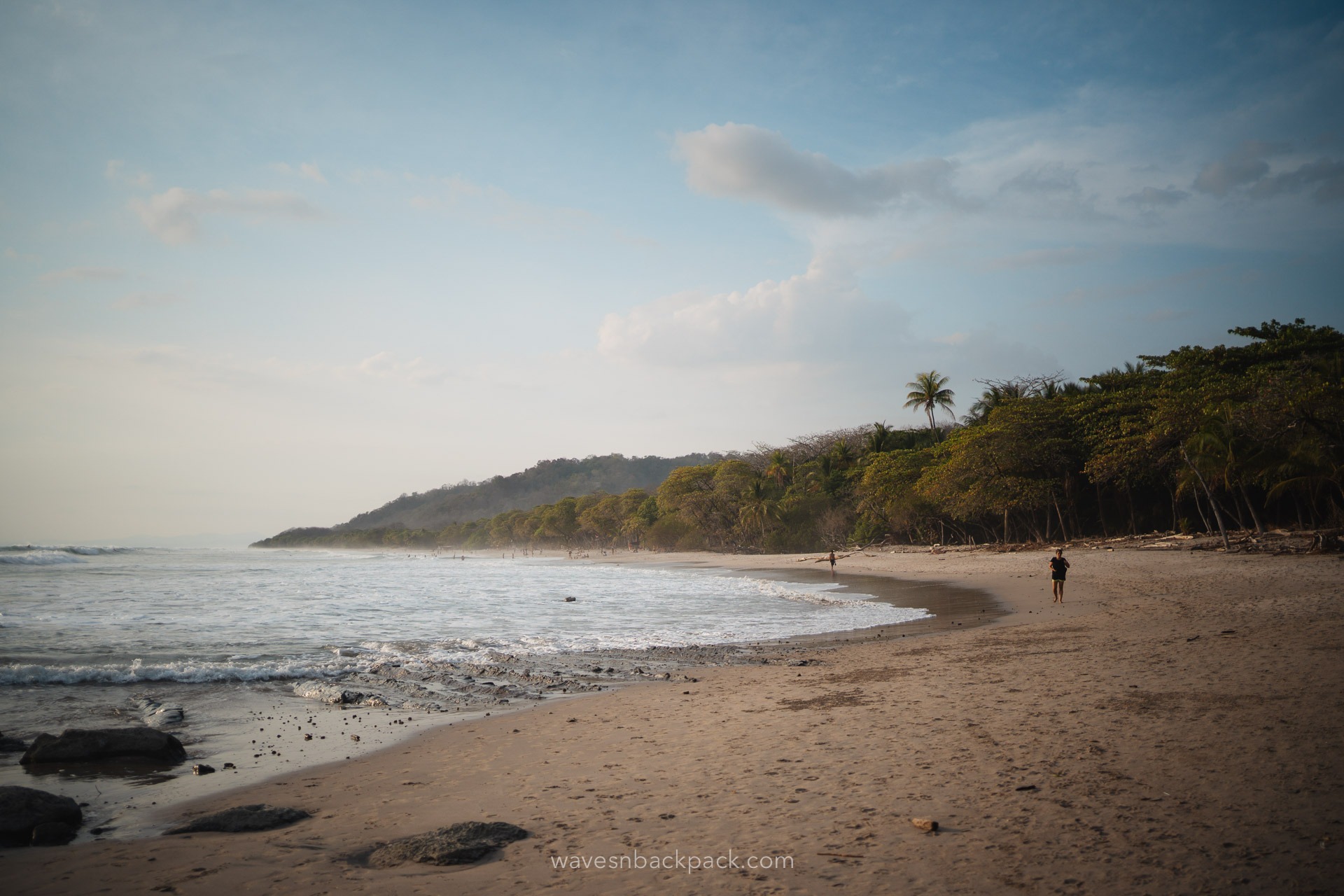
Playa Carmen and the area around it seamlessly blends with the neighboring towns of Santa Teresa and Mal País, creating a buzzing hub filled with cafés, restaurants, and surf shops. Whether you’re looking for a relaxed day in the water or a sunset session followed by some good food, Playa Carmen is the perfect spot to soak in Costa Rica’s surf and beach culture.
- Skill Level: Beginner-friendly
- Wave Type: Gentle beach break with mellow waves and slower sets
- Important Notes: This is a popular spot for surf lessons, so expect crowds during peak hours.
Playa Hermosa
Playa Hermosa, just north of Santa Teresa on Costa Rica’s Pacific coast, is a peaceful and picturesque surf spot known for its wide, sandy beach and forgiving waves.
Not to be confused with the Hermosa in Jaco, this wide, sandy beach is perfect for beginners and those looking to improve their skills.
The break offers long, smooth rides that are ideal for beginners and intermediate surfers, especially during mid to high tide when the waves become more manageable. On smaller days, it’s also a favorite for those looking to practice their style on mellow and fun waves.
Unlike the busier beaches nearby, Playa Hermosa has a more relaxed, uncrowded vibe, making it perfect for those seeking a more serene Costa Rica surfing experience. Surrounded by lush greenery and a few cozy beachside cafés, it’s a great place to enjoy a quiet day on the water with stunning views.
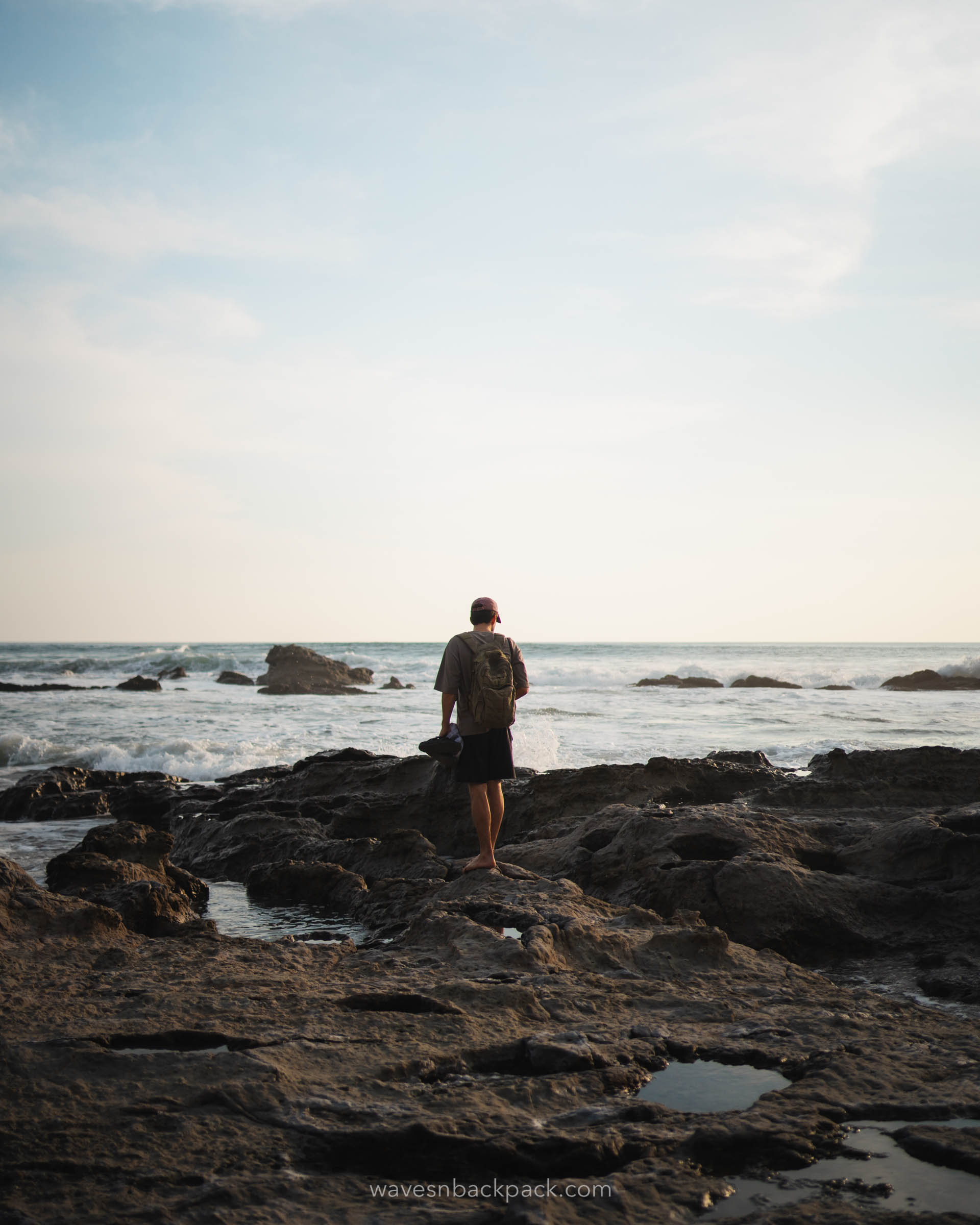
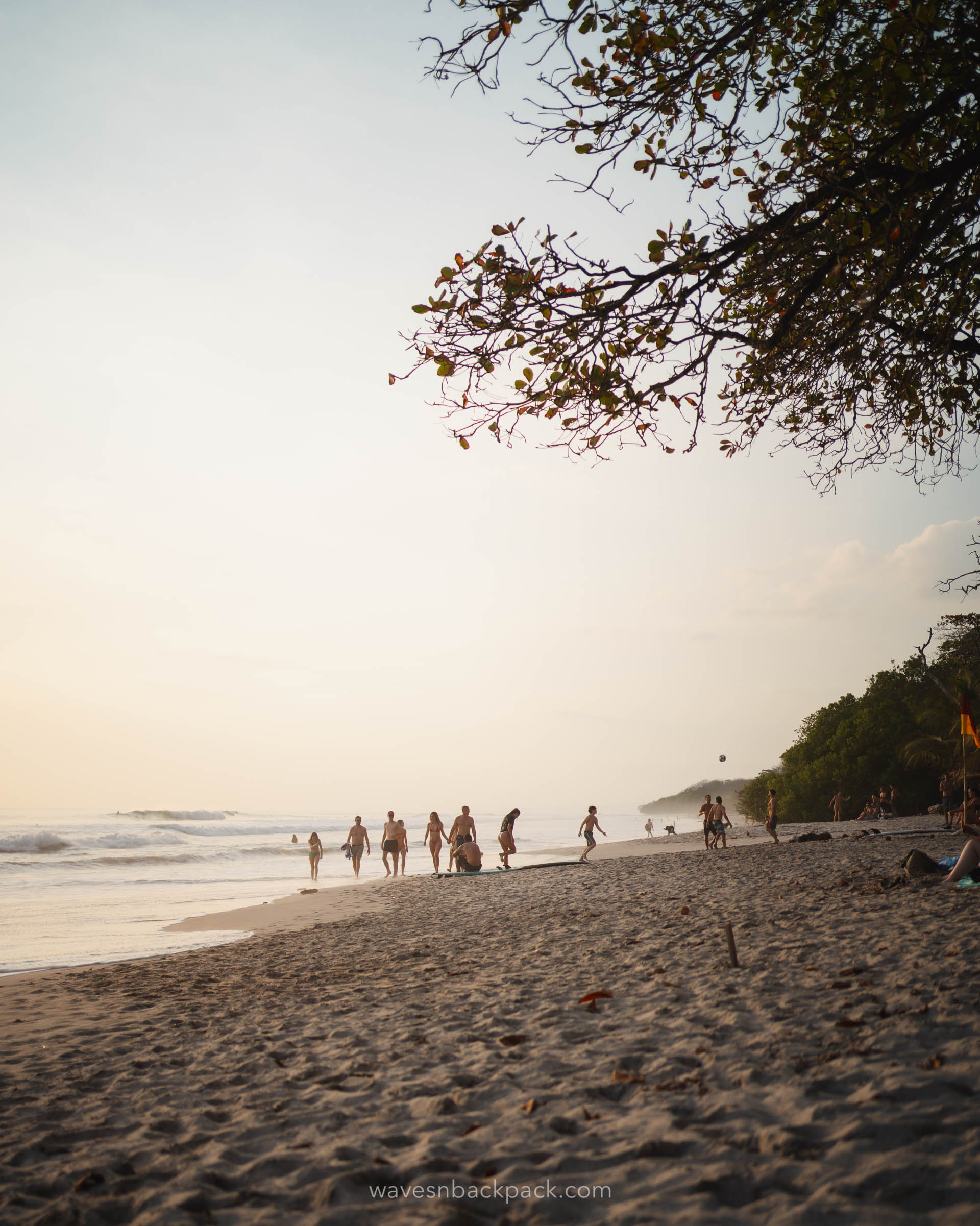
- Skill Level: Beginner to intermediate
- Wave Type: Wide beach break with smooth, playful waves
- Important Notes: A perfect place for improving your technique, especially during mid-tide.
Malpaís
Nestled at the southern tip of the Nicoya Peninsula, Mal País is a laid-back surf spot known for its scenic beauty and consistent waves. The beach break here offers playful A-frame peaks with long, cruisy sections that occasionally close out on the inside. The waves are generally forgiving, making it a great spot for casual surfers and longboarders.
However, during a strong southern swell, the waves can get larger and punchier, especially toward the northern end near Playa Carmen and Santa Teresa.
Unlike its neighboring hotspots, Mal País has a quieter, almost old-school surf vibe, with fewer crowds and a more relaxed pace. For those looking to mix exploration with Costa Rica surfing, the southern stretch near Cabo Blanco Nature Reserve offers a few reef breaks with more powerful waves.
- Skill Level: All levels
- Wave Type: Beach break
- Important Notes: Best during mid to high tide. Be cautious of exposed rocks.
Manzanillo
Manzanillo, located at the northern end of the Nicoya Peninsula, is a peaceful surf spot that offers a more secluded experience compared to its busier neighbors.
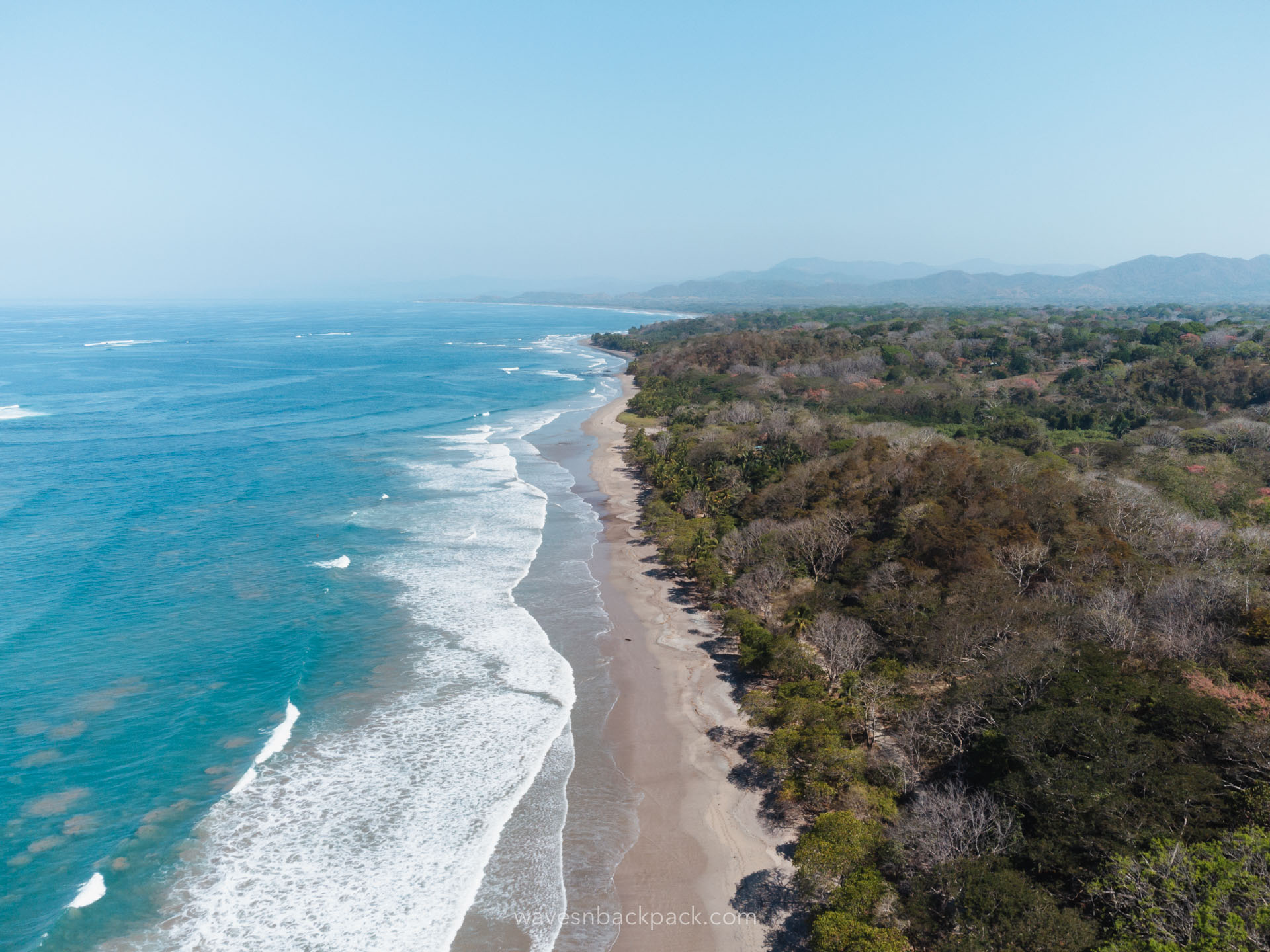
The beach features soft, rolling waves that break over a sandy bottom, making it a great option for beginners and longboarders. The swell is usually smaller and more forgiving, but when the conditions align, it can offer longer rides and fun, playful peaks.
Surrounded by lush vegetation and a sleepy village atmosphere, Manzanillo is perfect for surfers seeking a more relaxed, crowd-free Costa Rica surfing session. It’s also a great starting point for those wanting to explore nearby hidden breaks along the coast, combining a love for adventure with mellow, enjoyable surf days.
- Skill Level: Beginner-friendly
- Wave Type: Soft beach break, perfect for long rides
- Important Notes: Less crowded and great for relaxed surf sessions
Where to Surf in Pavones
Pavones Point
Tucked along Costa Rica’s southern Pacific coast, Pavones is famous for its legendary left-hand point break, offering one of the longest rides in the world.
On a good swell, you can ride for nearly a mile. The wave is powerful but fun, with a mix of sandy and rocky sections. The vibe in the water is often respectful, but it gets crowded when it’s pumping! Handle with care 🙂
- Skill Level: Intermediate to advanced
- Wave Type: Long, peeling left with sections for carving, fast hollow sections near the rivermouth, and a mellow tapering finish into the bay
- Important Notes: The lineup at the main takeoff point can get crowded, especially when the swell is pumping. Pavones relies heavily on a strong southern swell, and flat spells can last for weeks.
Punta Banco
Just south of Pavones, Punta Banco offers mix of left and right reef an breach breaks waves with scenic backdrops. The waves here are less predictable but deliver some gems, especially during mid to high tide.
It’s ideal for intermediate surfers looking for Costa Rica surfing waves with fewer crowds and stunning natural surroundings.
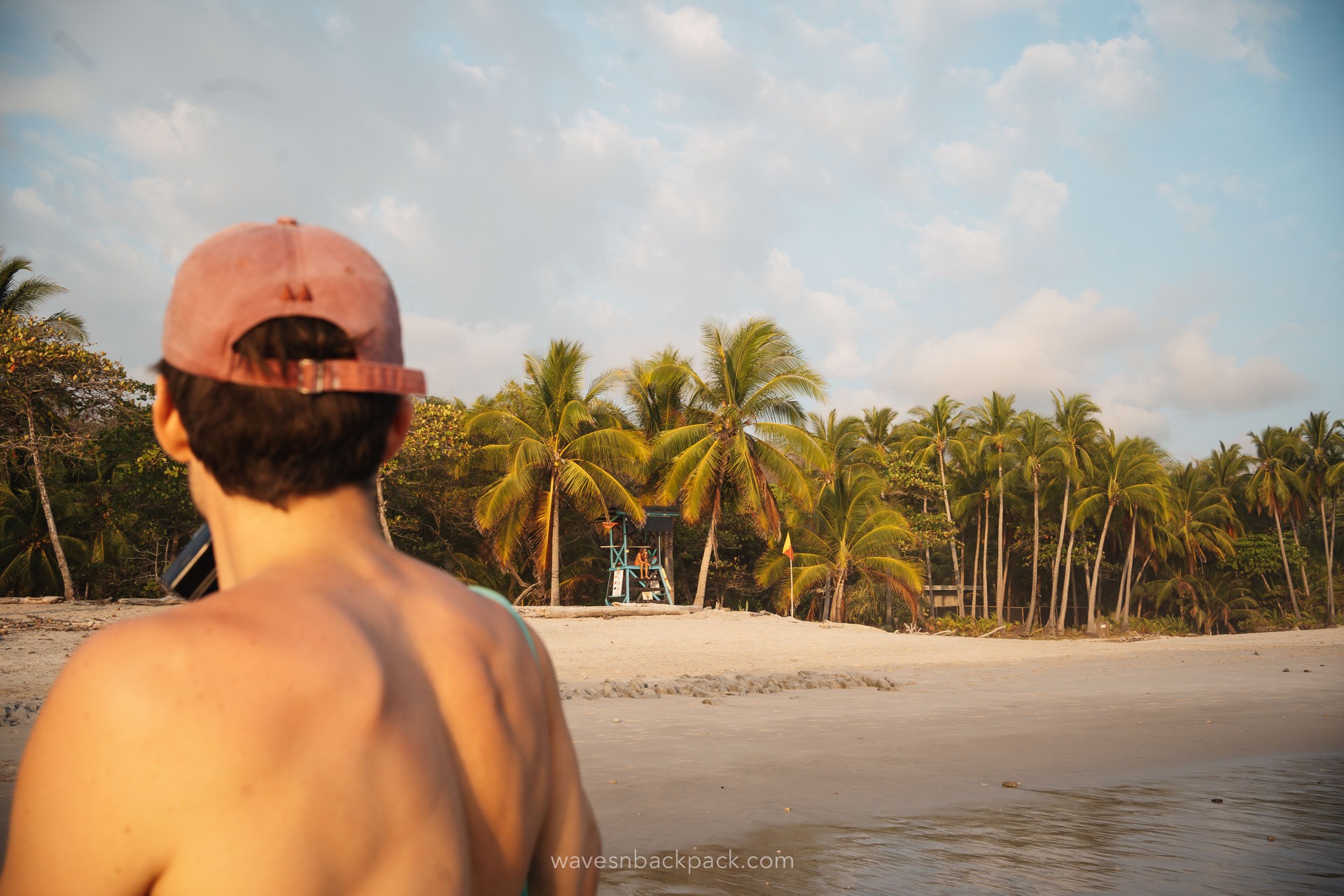
- Skill Level: Suitable for all levels, depending on the swell size
- Wave Type: Mix of point and beach break with both left and right-hand waves that can get powerful during bigger swells but remain gentle on smaller days
- Important Notes: The break is more forgiving than Pavones, but the reef sections can get shallow at low tide. It’s also a great spot to relax and enjoy the scenery if the waves aren’t firing. Perfect for those seeking a more peaceful surf session away from the hustle of the main points.
Rio Claro Rivermouth
Rio Claro Rivermouth, near the Golfo Dulce on Costa Rica’s Pacific coast, is a scenic and unique surf spot where the lush jungle meets the ocean. The break is excellent for intermediate surfers and known for its playful waves and laid-back vibe.
- Skill Level: Intermediate to advanced (conditions can challenge more advanced surfers during larger swells)
- Wave Type: A mellow rivermouth break with both lefts and rights that offer smooth, rolling waves, perfect for longboarders and cruisy rides
- Important Notes: The wave quality depends on the flow of the river and tide conditions. Be mindful of potential wildlife, as the area is rich in marine life, and currents near the river can be strong. It’s an ideal spot for those looking to enjoy uncrowded waves surrounded by nature, especially when the more popular points nearby get crowded.
Surf Spots at the Caribbean Coast
Puerto Viejo, located on the country’s Caribbean side, offers a laid-back surf atmosphere with a unique Afro-Caribbean flair – for us the perfect location to start your trip. This region is best known for its pristine beaches, colorful culture, and vibrant nightlife. It’s also home to the famous Salsa Brava wave, known as one of the heaviest waves in Costa Rica. When you are not surfing, we can only recommend only to go for long walks on the beautiful beaches like Manzanillo or Punta Uva.
Costa Rica Surfing: Where to Surf in Puerto Viejo
Salsa Brava
Salsa Brava is often regarded as the Caribbean’s heaviest and most famous wave in Costa Rica, drawing in experienced surfers looking for a serious challenge. This powerful reef break produces thick, fast barrels that can rival some of the world’s top waves.
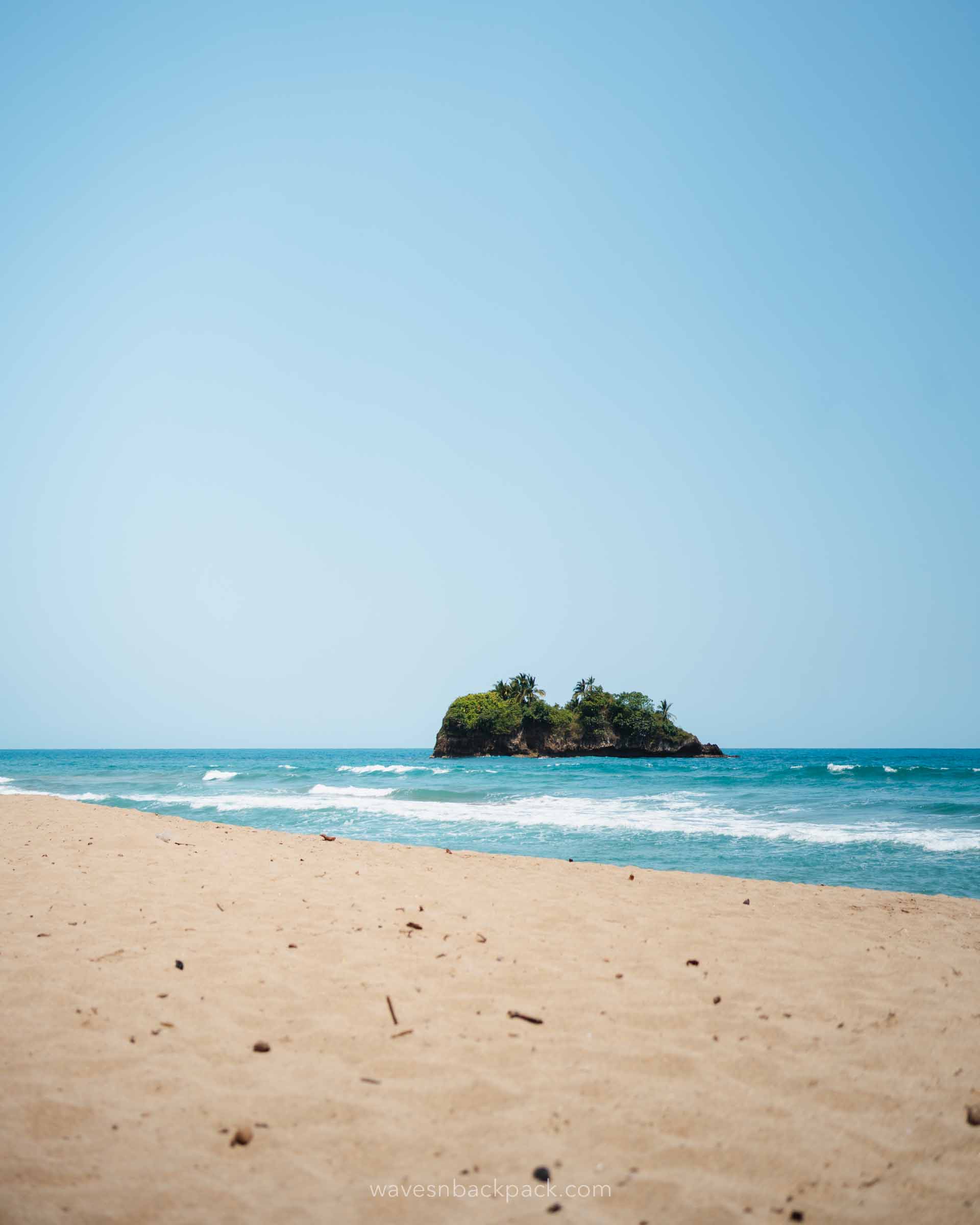
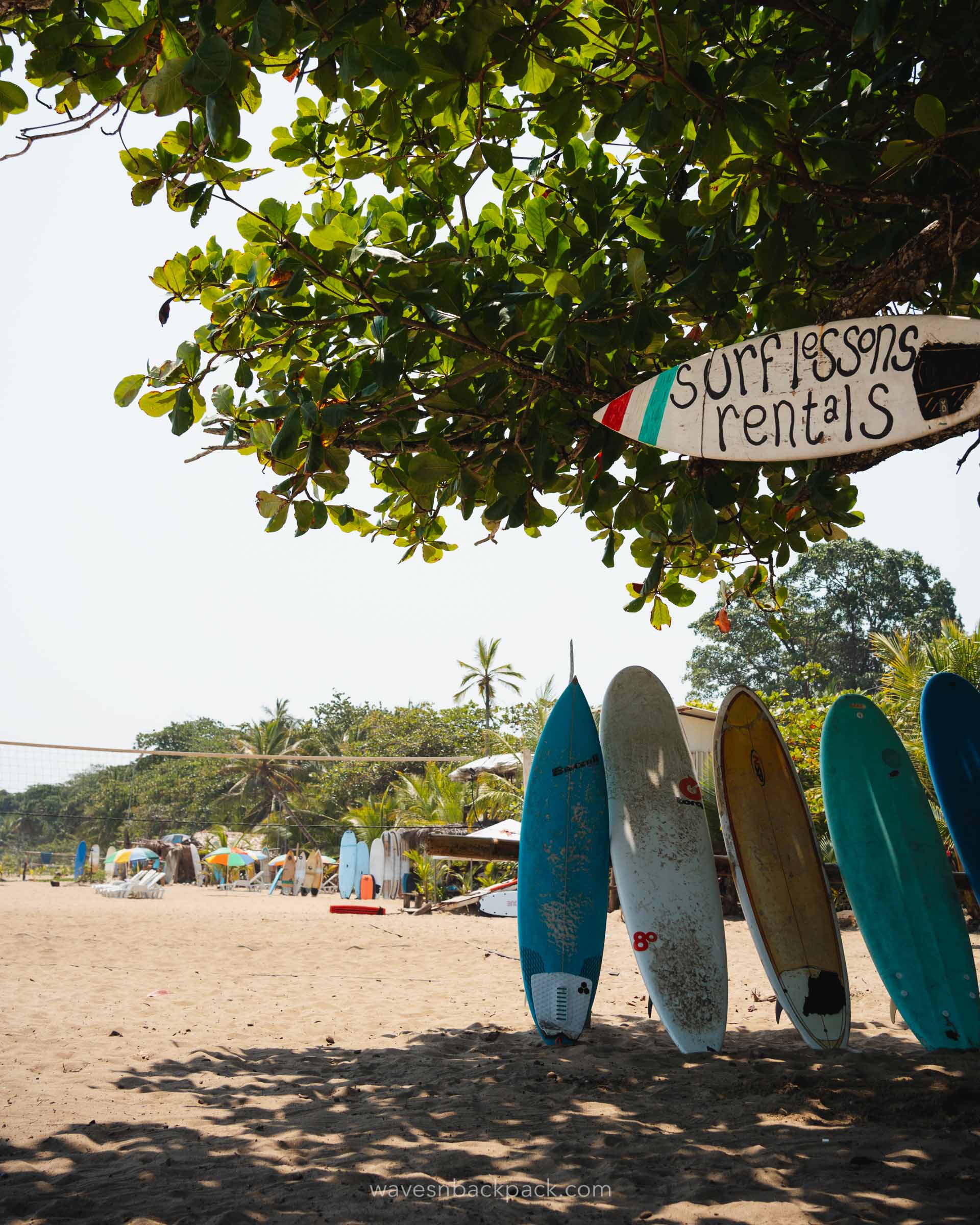
The break offers two key sections: The main takeoff point is intense, with a steep drop that requires precision and confidence while the second provides a more spaced-out lineup but still requires expert timing and skill to navigate its heavy drops.
On bigger days, the wave’s signature double-up sections can create hollow tubes that demand expert-level skills to navigate.
Despite its beauty, Salsa Brava is not for the faint of heart – the shallow reef below adds an extra layer of risk. However, for those up to the task, it’s an unforgettable ride. But: The waves here aren’t about long open faces – they’re all about getting barreled or making a quick escape.
Just a short walk from the lively town of Puerto Viejo, Salsa Brava’s iconic waves, combined with the laid-back Caribbean vibe, make it a must-visit for thrill-seekers chasing world-class surf.
- Skill Level: Intermediate – Advanced
- Wave Type: Reef break, fast and hollow
- Important Notes: This spot is best during high tide to avoid exposed reef sections. Protective gear like a helmet is recommended due to the sharp coral.
Playa Cocles
Playa Cocles, located on Costa Rica’s Caribbean coast, is a lively beach break known for its consistent waves and stunning tropical setting. The sandy bottom makes it a popular spot for surfers of varying skill levels, though the waves can pack some punch, especially when the swell picks up. Depending on the conditions, you’ll find both left and right-hand peaks, with the best Costa Rica surfing experience typically rolling in during mid to high tide.
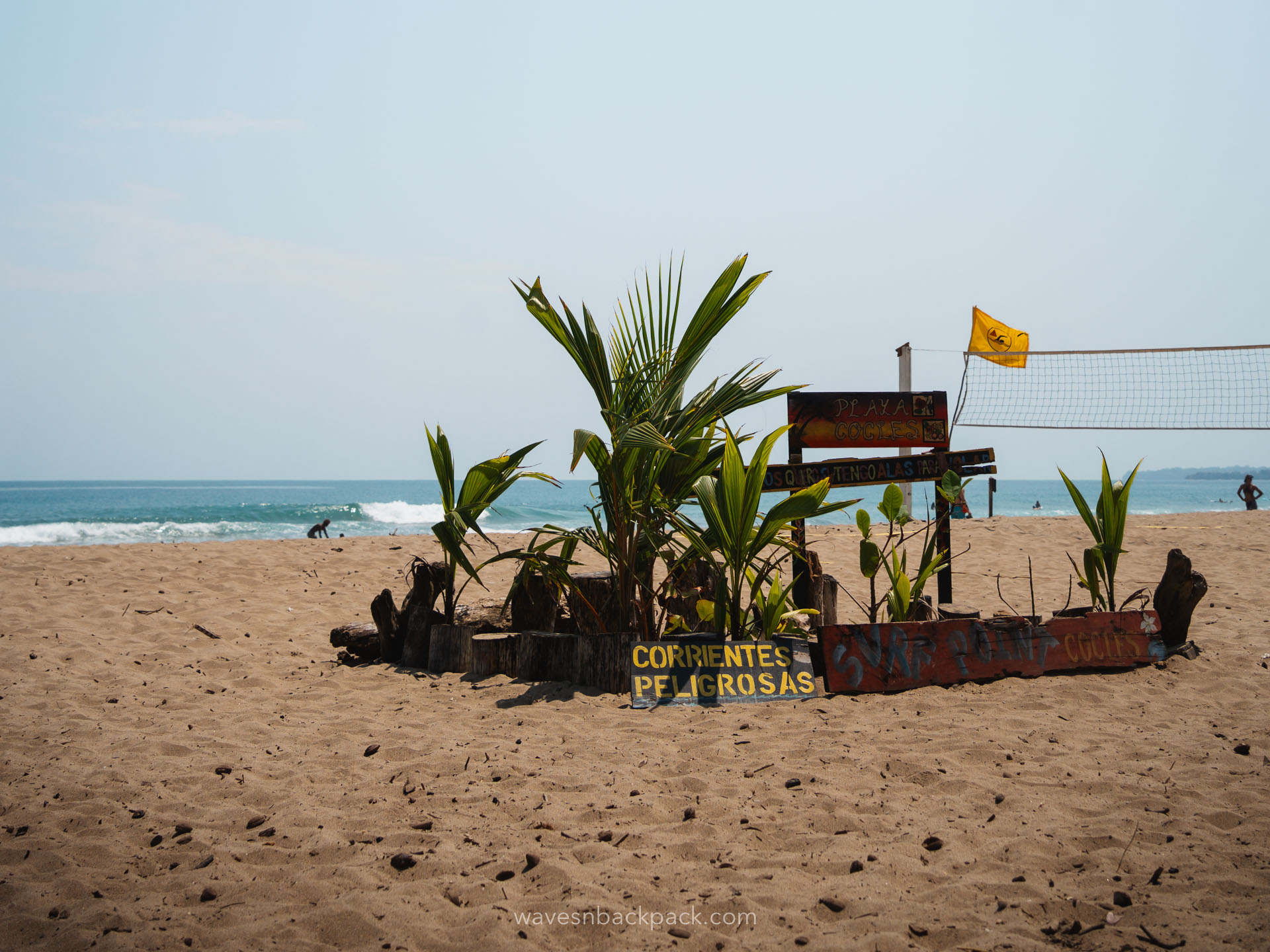
The atmosphere at Playa Cocles is vibrant, with a laid-back vibe that attracts both locals and travelers. The nearby town offers plenty of cafés, surf shops, and places to unwind after a session. Whether you’re looking to improve your skills or enjoy a fun day in the water, Playa Cocles is a go-to spot for a great Caribbean surf experience.
- Skill Level: Intermediate
- Wave Type: Consistent beach break with powerful sets
- Important Notes: Mornings tend to offer cleaner waves before the afternoon winds pick up. Don’t forget your sunscreen – this spot can get hot!
Playa Negra
Playa Negra is a laid-back beach break known for its consistent yet mellow surf, ideal for those looking for an uncrowded experience. The waves break both left and right, with the best conditions occurring when offshore winds blow from the west and swells come from the east or northeast. This spot offers a mix of beach and point break.
While the wave isn’t particularly powerful, it’s a perfect choice for longboarders and those progressing from whitewater to more defined peeling waves. However, caution is advised due to rip currents and the occasional jellyfish. The beach’s welcoming vibe and relatively low crowd levels make it an excellent location for intermediate surfers seeking to refine their skills.
Aside from the wave itself, the black-sand beach and surrounding tropical scenery add to the charm. Just a short drive away, you’ll find other fun breaks, making Playa Negra an excellent stop for those looking to explore more remote parts of the Caribbean coast.
- Skill Level: Intermediate
- Wave Type: Beach break with consistent mellow waves, left and right waves
- Important Notes: The sandy bottom makes it a safe place to practice. Ideal for longboarding and first-time surfers.
Costa Rica Surfing: Surf Seasons
When planning your surf trip to Costa Rica, it’s crucial to know that the surf conditions vary depending on the time of year and the coast you’re heading to. The country’s surf seasons can be split into the High Season, Shoulder Season, and Low Season – with each offering different experiences for surfers of all levels.
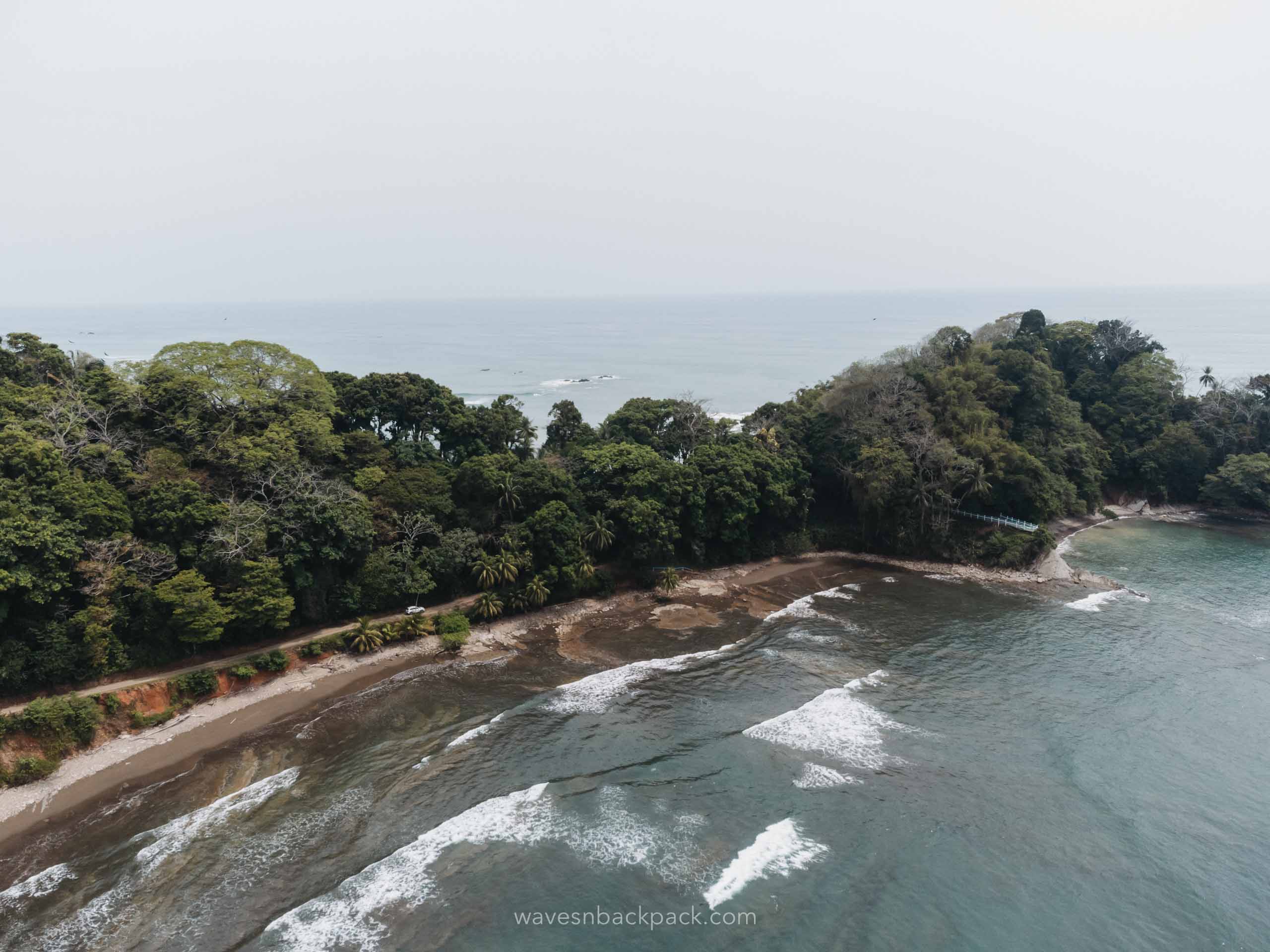
Below is an overview of what to expect on the Pacific and Caribbean coasts.
Surf Seasons at the Pacific Coast
The Pacific Coast is home to legendary surf spots like Tamarindo, Nosara, and Santa Teresa, attracting surfers from around the world.
High Season (December to April)
- Conditions: Offshore winds and consistent swell make this the prime surf season.
- Surf Level: Perfect for beginners and intermediates due to smaller, cleaner waves in the mornings. Advanced surfers can still find more powerful reef and point breaks, especially further south.
- Tips: Arrive early to popular spots as they can get crowded during the dry season. Bring strong sunscreen – shade is limited.
Shoulder Season (May to August)
- Conditions: Swell size increases with the rainy season’s arrival, but mornings often remain glassy before afternoon rains hit.
- Surf Level: Ideal for intermediate to advanced surfers who want bigger, uncrowded waves. Beginners may find gentler beach breaks on days with smaller swells.
- Tips: Don’t let the rain scare you – cloudy skies mean fewer people in the water, and the lush surroundings come alive during this time.
Low Season (September to November)
- Conditions: This is the peak of the rainy season, with frequent downpours and stormy seas. Some dirt roads may become impassable.
- Surf Level: Best suited for experienced surfers comfortable in bigger, unpredictable waves.
- Tips: Check the weather and wave forecasts carefully and consider staying near more accessible towns like Jaco or Dominical for safer logistics.
Surf Seasons at the Caribbean Coast
The Caribbean Coast is a less obvious but rewarding surf destination, known for gems like Puerto Viejo and its famous break Salsa Brava.
High Season (November to March)
- Conditions: This is when the Caribbean sees its largest swells, driven by northern hemisphere storms.
- Surf Level: Advanced surfers will love the hollow, powerful barrels at Salsa Brava, while intermediate surfers can explore Playa Cocles or other nearby beach breaks.
- Tips: The Caribbean coast is famous for its vibrant culture – don’t miss out on the food and reggae beats after your sessions!
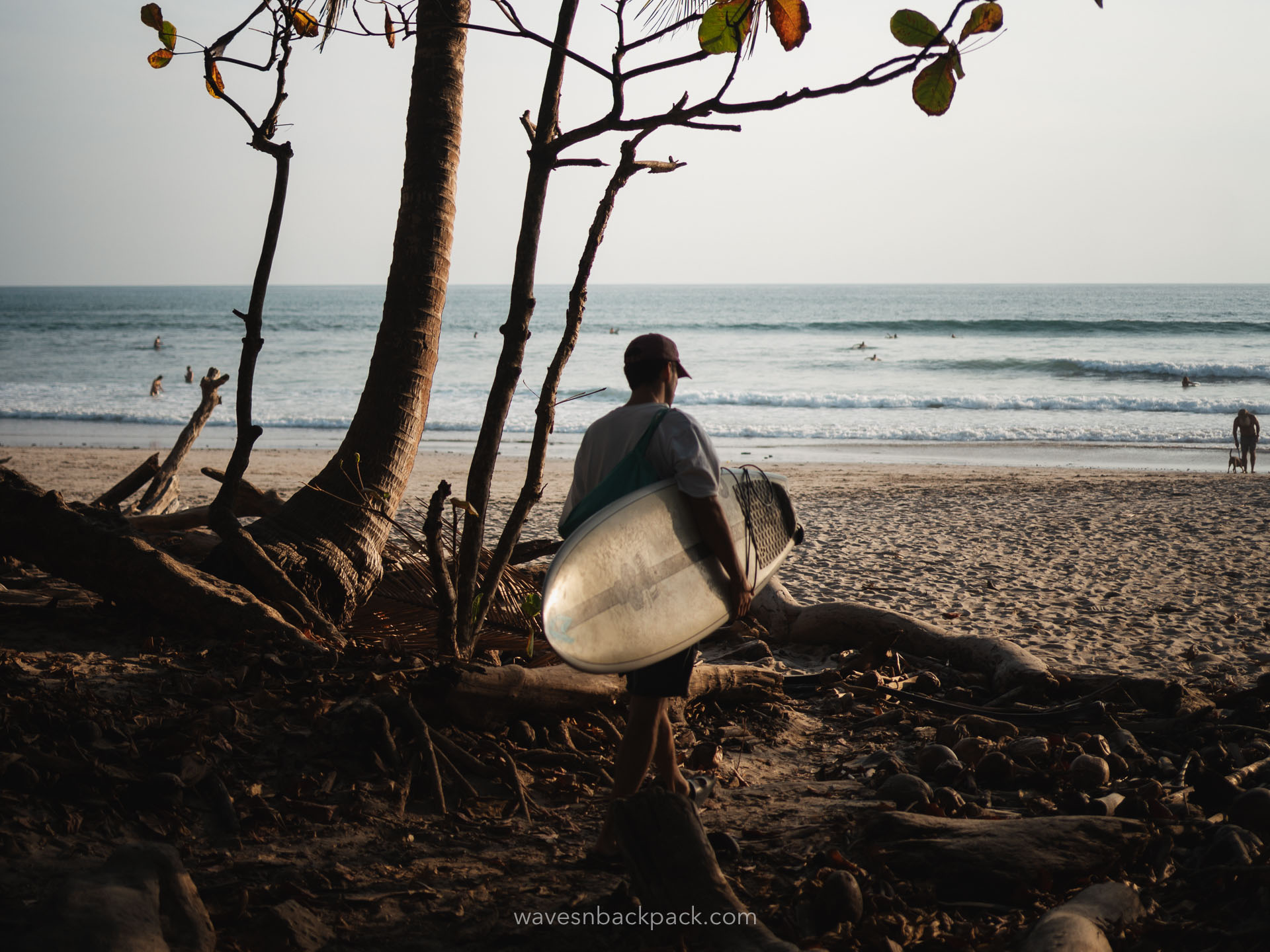
Shoulder Season (April to July)
- Conditions: Smaller, more manageable swells roll in, making for fun, playful waves.
- Surf Level: A great time for beginners and intermediates to enjoy cleaner conditions and less intense breaks.
- Tips: The vibe is laid-back, and accommodations are less busy – perfect if you’re seeking a more relaxed experience.
Low Season (August to October)
- Conditions: The Caribbean can experience long periods of flat water during this time, with occasional small swells.
- Surf Level: Beginners can use this time to practice paddling and catching gentle waves when conditions allow. However, it’s not the best season for waves.
- Tips: Use this period to explore Costa Rica’s incredible jungles, waterfalls, and wildlife if the waves go quiet.
Both coasts of Costa Rica offer year-round surf opportunities – it all depends on what you’re looking for: If you’re after consistent waves and tropical vibes, the Pacific is your best bet. However, if you’re seeking less crowded breaks with a unique atmosphere, don’t overlook the Caribbean Coast.
➳ Also read: Best Time to Travel to Costa Rica
How to get to Costa Rica?
Getting to Costa Rica is fairly easy, with several international airports connecting this Central American surf haven to the rest of the world.
Juan Santamaría International Airport (SJO) – San José
- Location: Near the capital, San José, in the country’s Central Valley
- Best for: Access to both the Pacific and Caribbean coasts, especially if you want to keep your options open
- Travel Tip: Most major international airlines fly into SJO. The airport offers plenty of car rental services, and local buses connect you to key regions if you’re traveling on a budget.
Daniel Oduber Quirós International Airport (LIR) – Liberia
- Location: Northern Guanacaste region
- Best for: Direct access to the Pacific Coast, especially surf spots like Tamarindo, Santa Teresa approx. 4h drive
- Travel Tip: This airport is perfect if you’re planning to surf the northwest beaches. It’s smaller than SJO but well-equipped and offers a more relaxed arrival experience.
Find your Flight to Costa Rica
Getting Around in Costa Rica
Car Rentals in Costa Rica
Renting a car is ideal if you want the freedom to explore different surf spots and remote beaches.
We had a 4×4 and were glad we did—not because we wouldn’t have been able to reach the surf spots otherwise, but because we nearly got stuck on the way to a waterfall. The night before, there had been a massive downpour, and we were driving off the main roads.
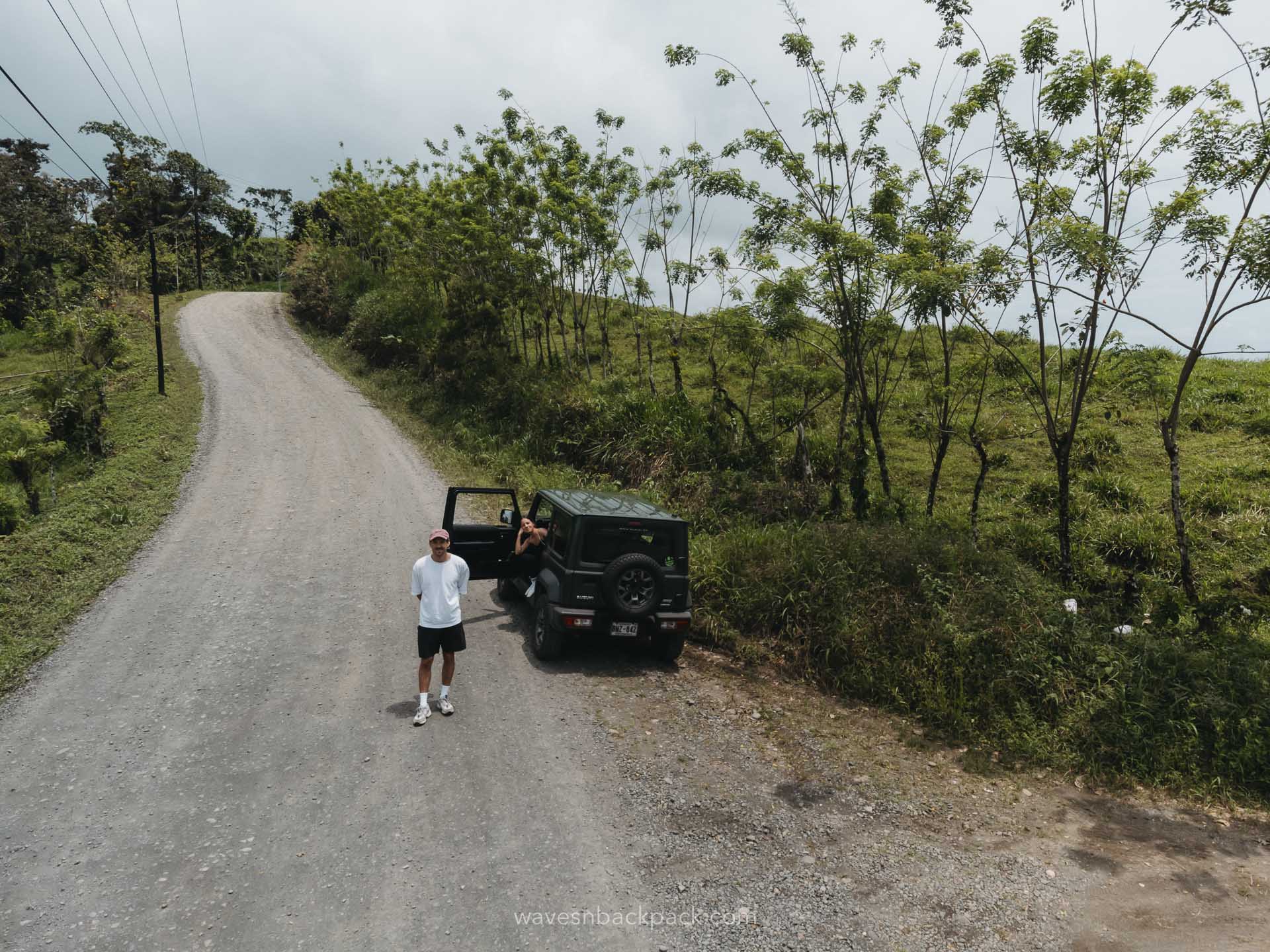
For reaching the surf spots (especially during the dry season), a 4×4 isn’t necessary. However, if you plan to travel off the beaten path, stay in accommodations on hills, or visit Costa Rica during the rainy season, having a 4×4 is a good idea. Otherwise, just make sure your vehicle has some ground clearance.
Tip: Use the Waze app. In Costa Rica it is often more accurate than Google Maps, especially in remote regions.
By the way, we often book our rental cars via Check24.de* – it’s a great platform where you can select all your preferred options (pro tip: always opt for a zero-deductible policy), compare providers easily, and find the best deal for your trip. Plus, if your plans change, you can usually cancel for free up to 24 hours before pickup. 🫰🏼
Shuttles and Buses in Costa Rica
Shared shuttle services are a great way to reach popular surf towns if you’re not renting a car. Public buses are the cheapest option, but be prepared for stopover in San José and longer travel times.
Costs for Surfing in Costa Rica
Surfing in Costa Rica is not only an incredible experience but also surprisingly affordable. Renting a surfboard typically costs around $20 USD per day, with some shops offering discounts for weekly rentals.
If you’re new to surfing or want to improve your skills, lessons are widely available. A one-hour group lesson usually costs between $40 and $60 USD, while private sessions can range from $60 to $90 USD (incl. surf board), depending on the location and instructor.
Many surf schools and surf camps provide a full package, including board rental and beach safety tips, making it easy for beginners to dive right into the waves.
Costa Rica Surfing: Where to stay?
The good thing is: there are tons of options. Generally speaking, you shouldn’t be on a super tight budget when in Costa Rica. It’s the most expensive country in Central America but not as expensive as we thought it would be.
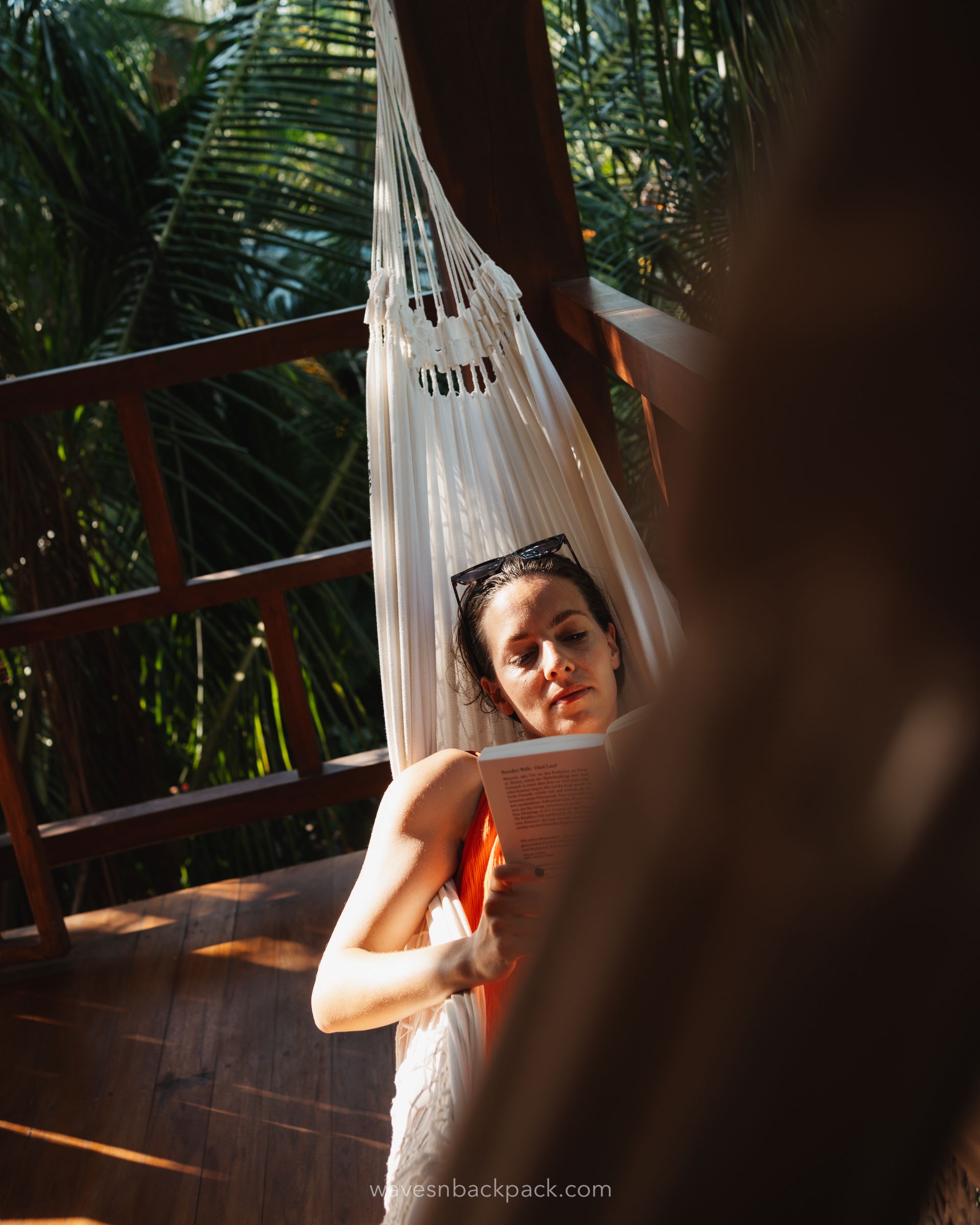
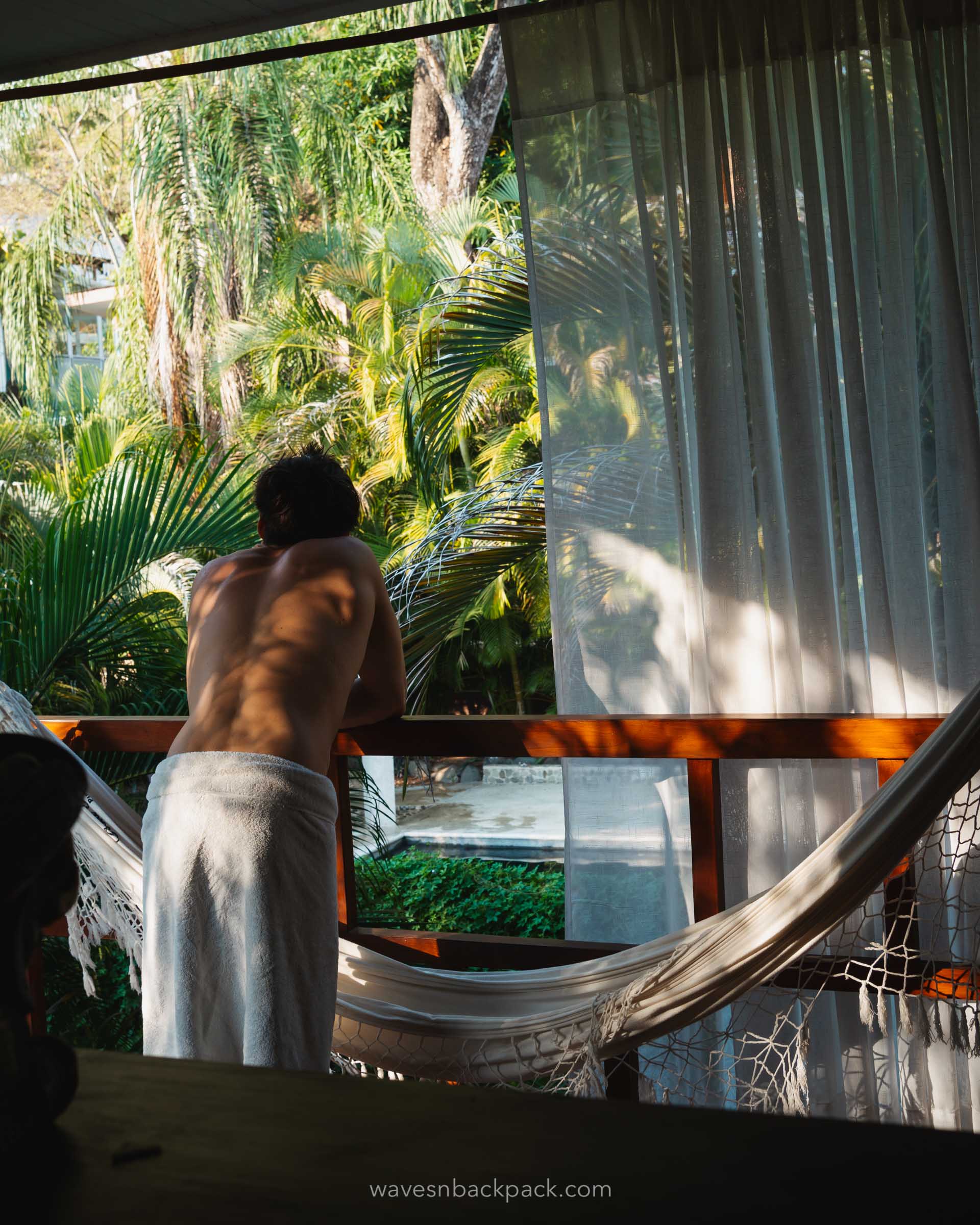
You’ll get decent accommodation for $80. In busier areas like Santa Teresa, stays tend to be a little more expensive.
In La Fortuna we paid $85 for an incredible lodge in the jungle with a private jacuzzi on the terrace. In Santa Teresa we spent $120, but would have gotten something cheaper, too.
Research a little where the surf spots are and where the accommodation is. Is there something better than waking up and walking to the surf? I doubt it. 🙂
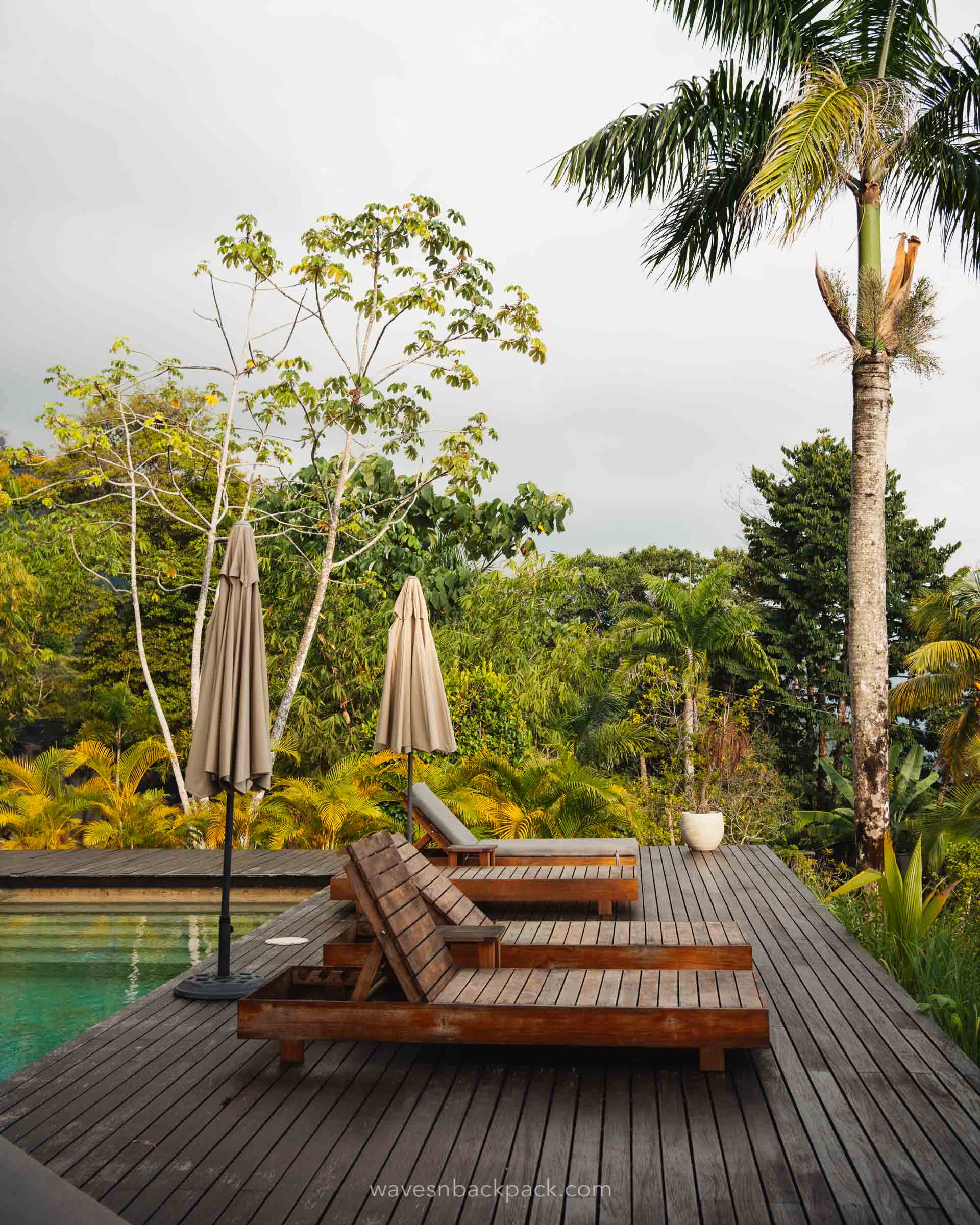
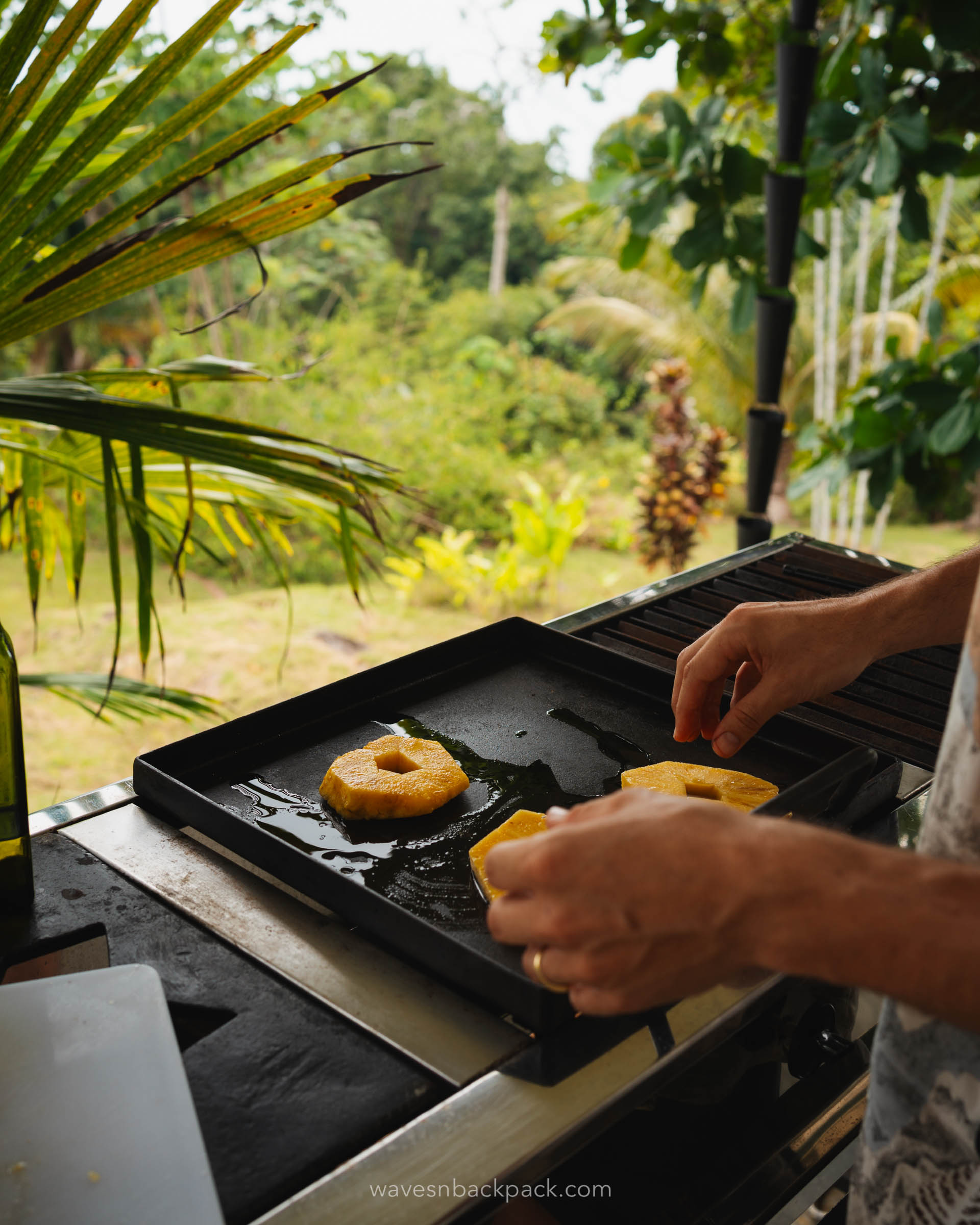
Here you can find our favorite accommodation while Surfing in Costa Rica:
Our favorite Accommodation while Surfing in Costa Rica
- Puerto Viejo: $ La Tica y la Gata | $$ Sonora Jungle & Yoga Retreat | $$$ Satta Lodge
- Santa Teresa: $ Surf Vistas Villas | $$ Ohana Villas (recommended <3) | $$$ Vista del Alma Boutique
- Uvita: $ Tropical Beach | $$ Tamandua Homes | $$$ Alma Tierra Mar (AirBnb)
Safety in Costa Rica
Costa Rica is generally considered a safe destination for travelers, with a welcoming atmosphere and a focus on tourism. However, like in any country, it’s important to stay aware of your surroundings and take basic precautions. Petty theft, such as pickpocketing or bag snatching, can occur in busy areas or at popular tourist spots, so it’s a good idea to keep your valuables secure and avoid leaving belongings unattended – especially at the beach while surfing.
A portable lockbox for storing items like house keys, wallets, or phones is a great way to keep your essentials safe while you’re in the water.
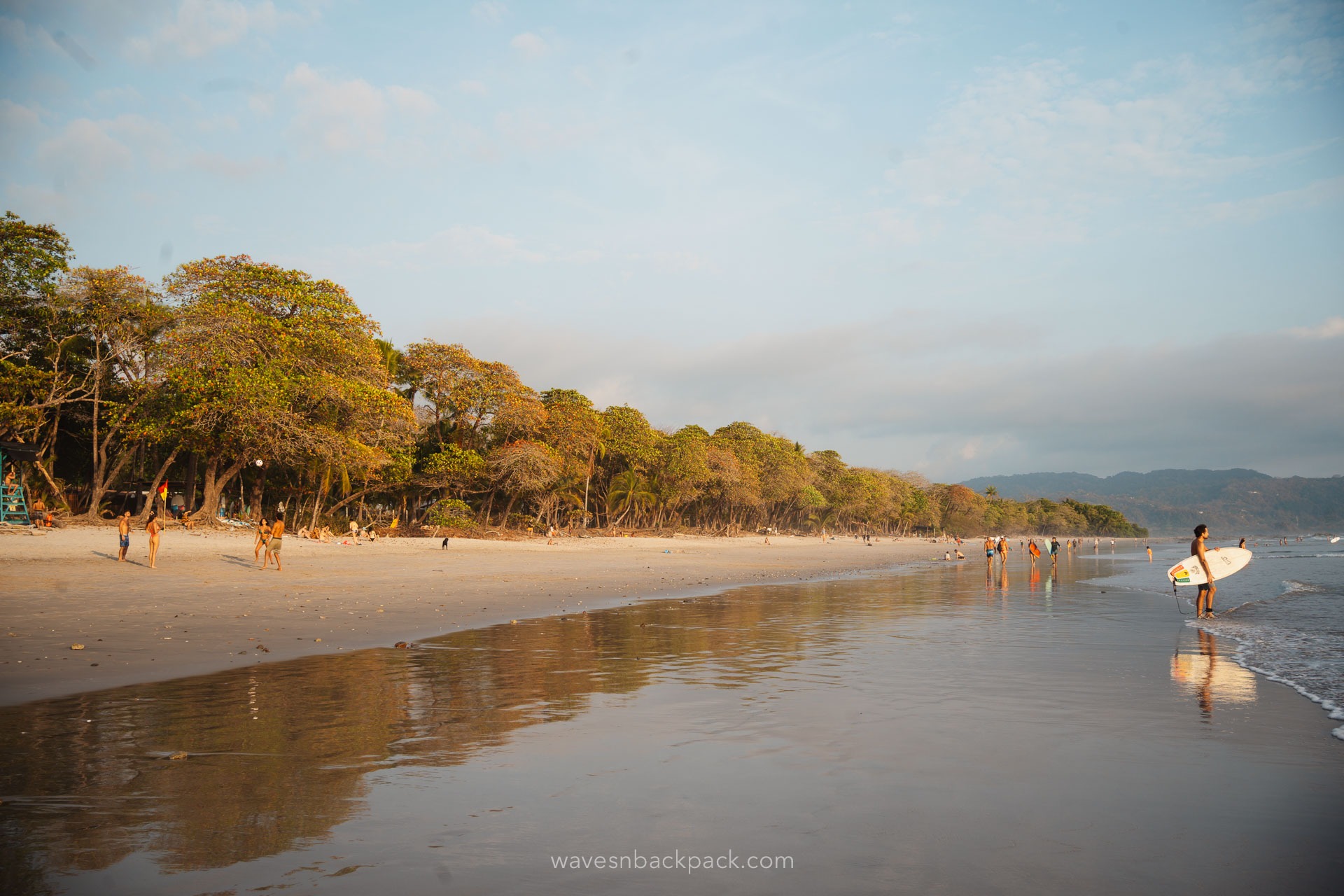
In rural areas, the roads can be challenging, particularly during the rainy season, so driving cautiously and having a reliable vehicle is crucial.
Be aware of strong currents, hidden reefs, and wildlife, especially in remote areas. By staying informed, trusting your instincts, and respecting the local environment, you can enjoy an incredible and safe trip through Costa Rica’s stunning landscapes.
Things to do in Costa Rica
Oh gosh. There is SO much to do besides Costa Rica surfing. Summing things up, Costa Rica – for us – was about surfing, yoga, hammocks, nature, hikes and backgammon in cafés.
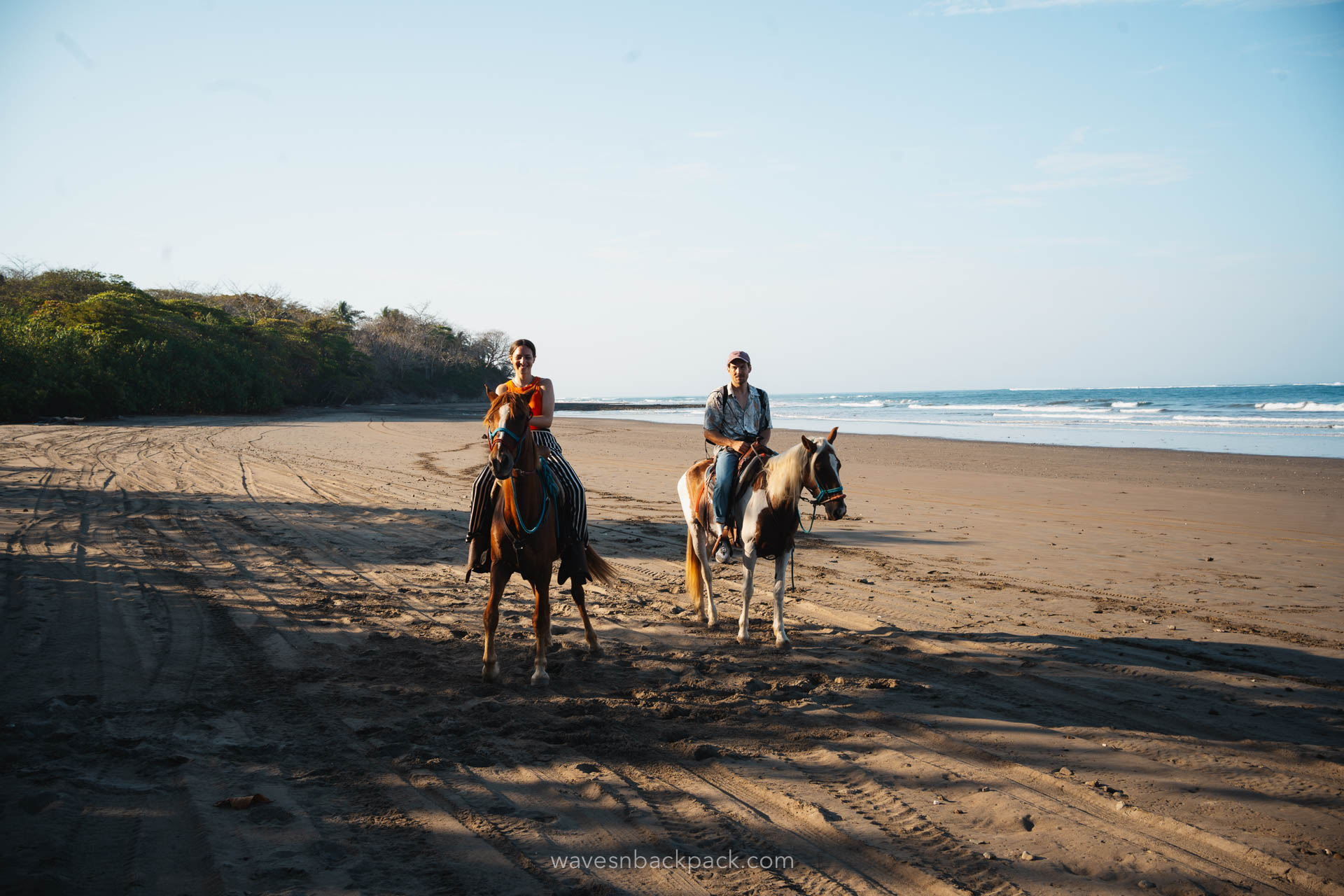
Here a shortlist of things you can do in Costa Rica besides surfing:
Activities in Puerto Viejo
- Explore Cahuita National Park: Walk through lush jungle trails where you might spot sloths, monkeys, and tropical birds.
- Jaguar Rescue Center: Visit this sanctuary to learn about the rehabilitation of local wildlife.
- Relax and Rejuvenate with Yoga: Many surf lodges offer yoga classes, perfect for winding down after a long surf session.
- Enjoy a Chocolate Tour at a cacao plantation: Experience the entire chocolate-making process, for example with Carribeans Chocolate
- Enjoy Local Cuisine: Savor Caribbean dishes like coconut rice, fresh fish, and sweet plantains.
➳ Also read: Our 10 best Things to Do in Puerto Viejo
Activities in Santa Teresa
- Horseback Riding: A memorable experience is taking a sunset horseback ride along the coast. Best adress is: @horizontehorse.st
- Cafe Culture: Unwind at one of the many beachfront cafes with fresh juices, coffee, or healthy smoothies.
Did we miss anything? Do you have any tips for surfing in Costa Rica? Feel free to share them with us in the comments. <3
_____________
This blog post contains affiliate links. This means that we receive a small commission if you book through one of the links. Of course, there are no additional costs for you.
We’ve poured a lot of heart and soul into this blog. We would be incredibly grateful if, with your help, we can continue to passionately provide detailed travel information for you. Thank you <3<3<3
_____________
More salt water?
➳ Want to explore as much of the country as possible alongside surfing? Check out our perfect 2-week travel itinerary through Costa Rica.
➳ Only have 7 days? Head over to our best 7-day Costa Rica itinerary.
➳ Planning to visit Mexico as well? Surfing in Puerto Escondido is calling!
➳ Or maybe Nicaragua? San Juan del Sur also offers some of the best waves waiting for you!


